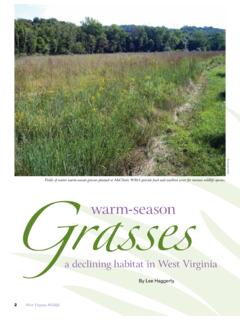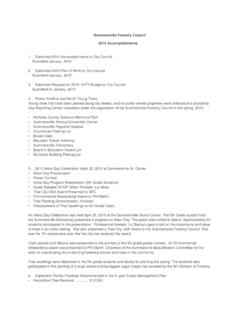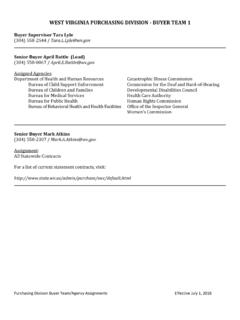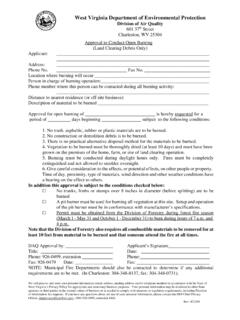Transcription of 2018 WEST VIRGINIA MAST SURVEY AND HUNTING …
1 2018 west VIRGINIA MASTSURVEY AND HUNTING OUTLOOK AUTHORS Ethan BartonColin CarpenterHolly MorrisEric RichmondChristopher Ryan Wildlife Resources Bulletin Number 18-4 west VIRGINIA division OF NATURAL RESOURCES WILDLIFE RESOURCES SECTION 2018 west VIRGINIA Mast SURVEY Ethan Barton, Colin Carpenter, Holly Morris, Eric Richmond and Chris Ryan The division of Natural Resources (DNR), in cooperation with the division of forestry , annually surveys the state to determine relative abundance of soft and hard mast produced by trees and shrubs of importance to wildlife populations. Information on the quantity of wildlife food is provided to our cooperators, hunters, and various media outlets. Mast surveys were completed at 247 locations covering all regions of west VIRGINIA in 2018. Professionals from a multitude of natural resources disciplines- including wildlife managers, foresters, wildlife biologists, retired managers and biologists, Natural Resources Police Officers, Natural Resources Commissioners, and a few other cooperators- devoted their time to collect data.
2 Without the efforts of these individuals, completion of this SURVEY would not be possible. We would like to extend our sincerest gratitude to everyone who participated in data collection for this year s mast SURVEY . The mast SURVEY is a relative estimation of mast produced by 18 different tree and shrub species. A sample of the mast SURVEY form is included in the Appendix. Cooperators are assigned counties and areas familiar to them to collect mast SURVEY information, and the same areas are generally surveyed each year to ensure consistency in the SURVEY across years. Mast crop production is subjectively evaluated as abundant, common, or scarce by species the observer encounters in the SURVEY area. The surveyor also documents species that are not encountered, and additional mast-producing species of local importance that do not appear on the SURVEY form.
3 The mast index is calculated for each species via the following formula: Mast Index= [(Abundant Observations/Total Observations) + ((Common Observations X )/Total Observations)] X 100 The mast index is calculated by species for each ecological region and elevation (high or low, relative to the local terrain of the SURVEY area). The current year s index is compared to the previous year s index. It is also compared to a long-term average index spanning the life of the SURVEY . Readers not familiar with west VIRGINIA ecoregions should refer to Figure 1 to determine the region in which they hunt. Many wildlife species are highly dependent upon mast crops produced by trees and shrubs, and dynamic factors in the animal s life history- such as survival and fecundity- are affected by mast availability. Caloric value available in mast is far more important to the survival of many wildlife species than the caloric value in agricultural crops, herbaceous plants, and supplemental feed.
4 Seeds and fruits from trees and shrubs are necessary not only for overwinter survival, but also for ensuring animals are in good physical condition for reproduction in following months. Wildlife biologists and managers are able to predict HUNTING prospects and population dynamics for black bear, squirrels, white-tailed deer, wild boar, wild turkey, and other game species by using mast quantity and quality information gathered during the annual mast SURVEY . Compared to the 2017 SURVEY (Table 1), the mast index for all species combined was down approximately 22%. Beech, walnut, oak, and hickory nut crops were all less abundant in 2018 than in 2017. Beech and walnut production were down more than 20%, while hickory production was down 13%. However, walnut and hickory production were respectively 31% and 37% above the 47-year average and should provide ample hard mast for squirrels.
5 Oak mast production was down significantly from 2017, with red oak, black oak, and scarlet oak declining more than 64%. Performance of these species was also significantly below the 47-year long-term SURVEY average, with the red oak/black oak group 70% below average and scarlet oak 64% below the average. Acorn production in the usually-reliable scrub oak was down more than 41% as compared to August 2017 and 31% below the long-term average. Chestnut oak production was down 30% from 2017 but remained 10% above the long-term average. White oak acorn production was nearly identical to the abundant crop produced in 2017 and was 42% above the long-term average. Even with abundant white oak acorn production, total oak mast production was nearly 24% below the long-term average. This should increase success of hunters pursuing white-tailed deer in many areas as they will need to cover more area while foraging to meet their nutritional needs, thereby making an encounter and harvest opportunity more likely for hunters afield.
6 All soft mast producing species, except yellow-poplar, were below their 2017 performance levels. Apple production was down more than 30% statewide, likely due to deleterious effects of abnormally wet conditions upon overall fruit and tree health during the spring and summer months of 2018. Crabapple, hawthorn, black cherry, and sassafras were all more than 20% below production levels observed during August 2017, and black cherry and sassafras production were more than 20% below the 47-year SURVEY average. Blackberry production was slightly below the long-term average and 12% below the amount observed in 2017. However, dogwood, grape, and greenbrier crop production was similar to levels observed last year, and fruit production in all of these species was above the long-term average.
7 This should provide some benefit for game birds such as ruffed grouse and wild turkeys, both of which use soft mast extensively when it is available. Hunters should take note of this information and know that they will have to cover additional territory to find grouse and turkeys, as these animals will be dispersed across the landscape and not concentrated around a particular food source. When considering all mast-producing species, the 2018 mast index was 22% below last year and approximately 5% below the 47-year SURVEY average (Fig. 2). Production of hickories, walnuts, and oaks were nearly 13% below the long-term average, and this difference was driven primarily by the sharp decline in the acorn crop. Total hard mast crop production was 29% below 2017 levels and 5% below the long-term average.
8 Hunters should always pay attention to mast crop production in their area (Table 3). SURVEY year 2018 revealed a crop that was generally less in quantity than that of 2017 across almost all ecoregions of the state. Ecoregion 3- the southern counties of west VIRGINIA - experienced a mast crop that was slightly more abundant than in 2017, although it remained more than 30% below the long-term SURVEY average. Red oak production in that region was much lower in 2018. Deviation from the long-term average across other ecoregions ranged from 20-51%, with the largest difference in the state s eastern panhandle (region 1) and central highlands (region 2). Comparisons to the long-term average provide a more tempered index to mast crop production than do annual comparisons, wherein relatively small variations in the production of a particular species can largely influence percent change indicated by the comparison and therefore may not provide a representative index to true mast abundance.
9 Considering long-term comparisons, the mast crop of SURVEY year 2018 appears to be a rather mixed one, and local scarcity of wildlife food resources is likely when there are a lack of white oak trees. When the mast SURVEY began in 1971, our main purpose was to use it as a method to forecast annual squirrel populations and HUNTING prospects. However, annual mast production conditions affect overwinter survival and reproductive success of many other wildlife species in subsequent months or years. We recommend hunters review regional trends in mast production as reflected in Tables 3 and 4 to learn the wildlife food conditions in the region of the state they hunt. There are always regional and local differences in mast production, but results recorded in the mast SURVEY should provide hunters a representative regional picture of true conditions on the ground.
10 2018 Mast SURVEY Highlights All Species Combined mast index is approximately 5% below the long-term averagestatewide. All Hard Mast Species mast index is below the long-term average by a similar marginstatewide. While White Oak acorn production levels are very similar to last year, productionamong other oak species is significantly below that experienced last year. WhiteOak is still significantly higher than the long-term average and should supply a goodfood source. Hickory, walnut, and beech production levels are well below those of last year. Soft mast production levels were generally well below those experienced last year and below the long-term average. Apple production was more than 30% down from last year and 8% down compared to the 47-year SURVEY average. 4 Figure 1. Ecological regions of west VIRGINIA 's mast 1. 2018 statewide index compared to 2017 mast DifferenceBeech4738-20 Walnut6650-23 Hickory7666-13 White Oak52533 Chestnut Oak5236-30 Black/Red Oak4512-72 Scarlet Oak3312-64 Black Cherry5236-31 Grape4645-1 Scrub Oak4225-41 Yellow Poplar495715 Hawthorn6839-43 CrabApple7048-31 Dogwood5956-5 Blackberry5548-12 Greenbrier4241-4 Sassafras3528-21 Apple7853-32 All Species5442-22 SpeciesAvg Index 2018 Percent DifferenceBeech3938-3 Walnut385031 Hickory486637 White Oak385342 Chestnut Oak333610 Black/Red Oak4212-70 Scarlet Oak3312-64 Black Cherry4636-22 Grape42459 Scrub Oak3625-31 Yellow Poplar465723 Hawthorn4939-19 CrabApple5448-11 Dogwood495614 Blackberry5148-5 Greenbrier40413 Sassafras3628-22 Apple5753-8 Other6842-38 Table 2.















